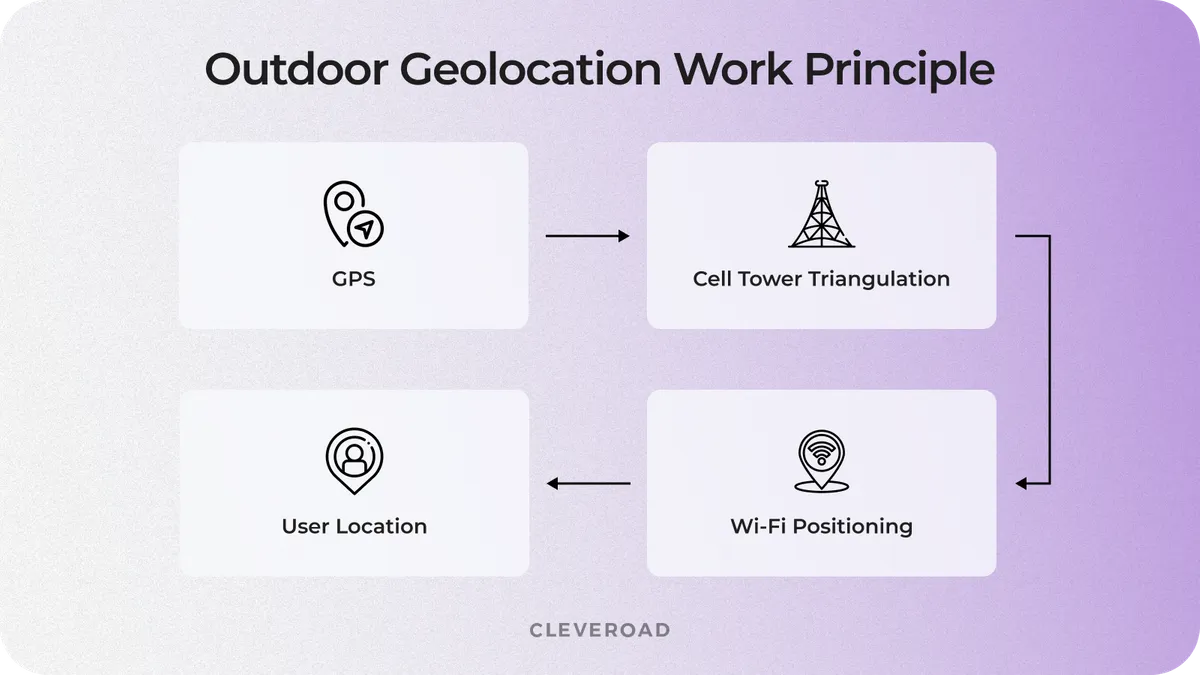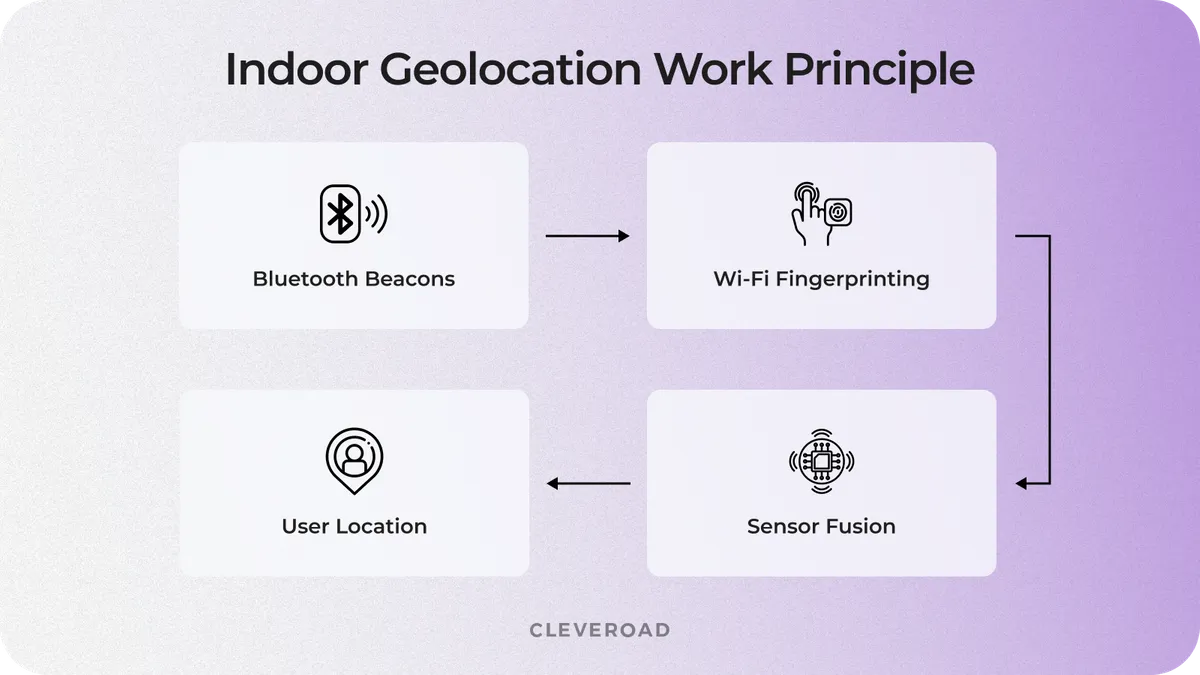How to Make a Location-Based App: Benefits, Types, Development Flow
Updated 20 May 2025
17 Min
20376 Views
Now it’s hard to find an app that doesn’t use geolocation. People track deliveries, order rides, and find nearby services with just a few taps, and won’t ever go back. At the same time, for you as a business, building a location-based app is a smart move to boost engagement, improve customer experience, and increase conversions. But how to make a location based app?
In this extensive guide, we’ll help you understand how you can boost your business efficiency by creating a location-based app, explore the key benefits and app types, and offer practical tips to ensure a smooth development process, backed by a clear, step-by-step roadmap.
What is Geolocation in Apps For?
Overall, geolocation in apps is the technology that allows a mobile application to detect a user’s real-time location using tools like GPS, Wi-Fi, cell towers, or Bluetooth. It powers everything from ride-hailing and food delivery to dating and navigation apps.
Let’s discuss why businesses need geo-dependent apps through their core functions:
- Marketing function. Geolocation enables targeted campaigns, location-based offers, and geofencing to boost user engagement and conversions.
- Information function. This function allows users to get real-time information about the nearest places or objects within a specific location.
- Communication function. Companies can put places on the map to obtain customers’ feedback on select services, allow them to attach their own content, etc.
- Social function. Enable location check-ins, friend discovery, or sharing to increase in-app activity and brand visibility.
Location-based app market overview
Location-based app development has certainly become an indispensable tool for businesses worldwide. Below, you can discover vibrant statistics insights that will help you better understand why location-based apps are so popular worldwide:
- Forbes claims that over 90% of location-based marketing campaigns experience higher engagement rates compared to traditional advertising.
- Google highlights that 76% of people who conduct a local search on their smartphone visit a business within a day, and 28% of those searches result in a purchase.
- According to Business of Apps, the global navigation app sector is projected to reach $36.6 billion by 2028, growing at a compound annual growth rate (CAGR) of 14.8%.
As you can see, location-based apps effectively enable businesses to promote their services, while naturally increasing customer engagement and driving sales.
Location Based App Development Benefits
Now, you can take a closer look at how exactly you, as a business, can benefit from adopting location based mobile app development.
Real-time user engagement
Location-based apps allow you to connect with users' rights in the moment. Usually, it could be timely push notifications about nearby offers or promoting limited-time events. Real-time engagement promotes faster decision-making and impulse actions. This immediate interaction creates stronger customer relationships, boosts foot traffic, and increases sales opportunities.
Geo-aware operational efficiency
What is geo-awareness in the first place? Geo-awareness refers to an app’s ability to recognize a user’s physical location in real time and respond accordingly. With this tool, you can optimize resources by aligning operations with real-world activity. For instance, delivery and logistics teams can plan smarter routes, reduce fuel costs, and improve punctuality. On-site services like maintenance or medical response benefit from quicker dispatch and better territory management. Geo-aware location based mobile application lead to agile workflows, fewer delays, and improved customer satisfaction.
Personalized location services
Location intelligence enables hyper-personalized user experiences. With its help, apps can recommend nearby stores, offer tailored discounts, or even suggest local events that match the user's preferences. This adds real value to the user journey, which makes interactions feel more intuitive and relevant. For you as a business owner, it means higher conversion rates and improved customer loyalty.
Types of Location-Based Apps
Geolocation technology is used in any service-based business. They are not restricted to taxi services or the search for the nearest store. Navigators, guides, social media with geotagged pictures, route planning, fitness apps with track speeds relate to location-based services.
Let’s explore the core purpose of each type of geolocation apps and take a closer look at standout success stories from the most dynamic niches.
Maps and navigation
Maps and navigation apps form the backbone of location-based technology, helping users move through unfamiliar spaces with ease. These solutions go far beyond just offering directions by providing real-time traffic insights, suggesting optimal routes, and connecting users with nearby points of interest like gas stations, restaurants, or hotels. Businesses also integrate these APIs to power their delivery, ride-hailing, or logistics operations.
Enterprise App Today states that Google Maps dominates this category, with over 1 billion monthly users and about $11 billion in annual revenue, mainly through API licensing and ad placements.
On-demand services
Location-based app development for on-demand service relies on real-time geolocation to match service providers with nearby users. This category includes ride-hailing, food delivery, home services, and more. Location-based data ensures prompt service and higher user satisfaction, key components for user retention and business growth in this competitive space.
Undoubtedly, Uber is the most recognized on-demand service app. Business of Apps announced that Uber earned $43.9 billion in 2024 split between mobility ($25B) and delivery ($13.7B).
On-demand app development is a solid location-based app concept. Check out our detailed guide to learn about its cost, development specifics, and more
E-commerce
Geolocation helps e-commerce businesses customize user experiences based on local preferences, offer region-specific deals, and streamline last-mile delivery. For example, customers can see products available in nearby warehouses or schedule same-day delivery. Businesses use this data to optimize inventory distribution and localize marketing campaigns.
It’s not surprising that companies like Amazon integrate geolocation across their logistics and UX flows. For instance, Investopedia highlights that in 2023, it posted $574.8 billion in net sales, with a large portion attributed to its precision in location-aware fulfillment operations.
Travel apps
Location-based travel app development personalizes journeys by suggesting nearby attractions, enabling map-based accommodation searches, etc. Businesses in this domain benefit by offering tailored promotions and increasing user engagement through location-specific insights.
Airbnb uses geolocation to help users book stays around the globe. According to Business of Apps, in 2024, Airbnb reached $11.1 billion in revenue, powered by a location discovery experience.
At Cleveroad, we provide mobile app development services. With 13+ years of experience, we build all types of apps and seamlessly integrate geolocation to boost service efficiency and elevate the user journey
Fitness apps
Fitness apps use location tracking to log runs, bike rides, and outdoor workouts, offering visual progress tracking and route sharing. Users can join local challenges, compare stats with nearby athletes, or explore trails in real time. For you as a business, these features increase app stickiness, foster communities, and open up sponsorship and subscription revenue.
Strava is a top fitness platform for runners and cyclists. Business of Apps claims that It generated $275 million in revenue in 2023 by offering geolocation features and social competition tools,
| Location-based app type | Purpose | Real-world examples |
Maps and navigation | Provide directions, traffic info, nearby places | Google Maps, Waze |
On-demand services | Match users with nearby service providers | Uber, DoorDash |
E-commerce | Offer local deals, show nearby stores | Amazon, Instacart |
Travel apps | Suggest attractions, plan routes, guide trips | TripAdvisor, Airbnb |
Fitness apps | Track workouts using GPS, map routes | Strava, Nike Run Club |
How to Make a Location Based App
If you have a concept for a location-based app and are exploring how to bring it to life for your business, our team is ready to help you turn it into a fully functional solution. Below we’ll walk you through a comprehensive roadmap for location based mobile application development on the example of our proven Software Development Life Cycle (SDLC).
Step 1. Find a reliable IT vendor
To create a location-based app that’s competitive and user-ready, you’ll need to select a trusted software development partner with solid experience in mobile app development with geolocation integration. Besides, make sure the chosen candidate has a proven track record in your specific business domain and has a strong and intuitive portfolio you can look up. Also, it may be useful to check out platforms like Clutch and Goodfirms. There, you can assess the vendor’s past clients' reviews, highlighting their cooperation strategy, communication, and real-world deliverables.
At Cleveroad, we have extensive experience in location based app development and would like to briefly introduce one of our recent projects.
Cleveroad helped our client, UK-based business, create El Tab – mobile application that offers a unique subscription-based service for drinks in bars and pubs across London, Built with Flutter, the cross-platform app centers around a drink subscription model that lets users enjoy beverages at partner pubs nearby. Geolocation technology identifies which venues are close, while Apple Pay and Google Pay provide seamless payment options. The platform also includes an intuitive admin panel for managing users, partner pubs, and tracking subscription activity.
As a result, our client gained a scalable, user-friendly location-based marketplace for bars and pubs that boosted client engagement and helped partner venues attract a wider audience.
Here’s what Oliver Carew, founder of el Tab, says about collaboration with us:
Oliver Carew, founder of el Tab provides feedback about collaboration with Cleveroad
Step 2. Define app requirements and user flow
Once you’ve found ‘the one’, you’ll work with a Business Analyst and Solution Architect to strengthen your location app concept, shape core functionality, and logic. At Cleveroad, in tight cooperation with you, our experts, define precise user journeys: how users find nearby services, what permissions they grant, and how data flows. We also help you clarify your use cases and plan for features like map displays, real-time tracking, or location-triggered notifications.
Step 3. Choose the right tech stack
At this stage, we select the right technologies for location-based app development—a decision that directly impacts performance, scalability, and development speed. Our choice depends on the platforms you want to target (iOS, Android, or both), expected user load, scalability requirements, domain-specific needs, and your budget.
Based on that, we might use native tools like Swift or Kotlin, or cross-platform frameworks like Flutter or React Native. Once the tech stack is defined, our UI/UX designers craft user-friendly interfaces that seamlessly integrate geolocation features such as interactive maps, real-time routing, and distance indicators. Through design sprints and user feedback, we ensure intuitive navigation and smooth user flows before moving to development.
We’ll overview key peculiarities of geolocation technologies a bit further.
Step 4. Design an intuitive UI/UX
Our UI/UX designers craft user-friendly interfaces that seamlessly combine geolocation elements like interactive maps, real-time routes, and distance indicators with intuitive controls. We create prototypes of varying fidelity from basic wireframes that outline the app’s visual structure to fully clickable demos that simulate the complete user experience without backend integration. You’ll be involved through design sprints and feedback loops to fine-tune layout, colors, and flows before development.

Food delivery app designed by Cleveroad. Source: Dribbble
Step 5. Develop location-based app
Location-based app development process involves implementing geolocation features, integrating APIs, and ensuring performance, scalability, and accuracy. At Cleveroad, we follow agile software development methodology, which means that our developers build the app in two-week sprints. Such an approach allows us to establish a well-structured development flow and iterative feedback loops. During each sprint, we build and deliver specific parts of your app’s functionality, including location-based features. This iterative approach ensures steady progress and transparency.
We start by implementing core features like real-time tracking, routing, and geo-fencing. Then we connect your app to external APIs and location services (such as Google Maps or Mapbox) to ensure precise tracking, route optimization, and location-aware triggers. If needed, we also enable offline access and cache location data to keep your app functional even with limited connectivity.
Before release, our QA engineers conduct thorough end-to-end testing across a wide range of devices, operating systems, network conditions, and geographic regions. This ensures the accuracy and responsiveness of location tracking, correct behavior of geofencing and routing logic, and reliable integration with third-party services like maps or GPS APIs. We simulate real-world usage scenarios to detect edge cases, minimize latency, and guarantee seamless performance under varying loads.
Step 6. Launch, and gather feedback
We help you ensure a smooth launch of location-based apps through final QA testing across devices, networks, and real-world geolocation scenarios to verify GPS accuracy, geofencing, and map integrations. We handle App Store and Google Play prep, ensuring compliance with location access policies, setting up CI/CD pipelines, and integrating analytics tools like Firebase. After release, we monitor performance, user behavior, and provide hotfixes or updates as needed, ensuring stable scaling and value delivery from day one.
Once your location based mobile application is live, we help you monitor user behavior through analytics platforms like Firebase or Mixpanel. Based on these insights, we assist you with post-launch iterations, scaling, and new feature rollouts to keep your solution aligned with market demands.
Location-Based App Development Technologies
How to build a location-based app? Usually, it all starts with two core components: geolocation services and interactive maps. At the same time, geolocation services fall into two categories: indoor and outdoor. Let’s explore their differences and applications below.
Outdoor technologies
Outdoor navigation, like Google Maps, helps users with positioning themselves, showing genuine routes, and reaching destinations without any trouble. This navigation type is based on satellite imagery and GPS signals. Let’s talk about it in more detail.

Example of how outdoor geolocation works
GPS
All today’s mobile devices have an in-built GPS module, so GPS is by far the most popular way to locate a device outdoors. GPS receives signals from the satellite, and it’s highly precise (down to 15 meters/49 feet), works almost everywhere, and doesn’t require an Internet connection. But there’s a con – GPS is a huge battery drainer.
A-GPS
A-GPS stands for Assisted GPS Service. Location based mobile application that incorporates locating technology combining both GPS and Cell ID features, allowing it to submit a high level of accuracy. It generates merged data received from both the server and the satellite and transfers it through the Internet, utilizing Wi-Fi or cellular connection. The core benefits are good speed, enhanced responsiveness in “problem areas,'' and economical battery power usage.
Cell ID
If a GPS signal is unavailable for some reason, the device’s location can be determined by cell towers close to the phone. It's a good solution for megapolises with a huge number of cell towers, but being less accurate than GPS, it depends on how close the base transceiver station is.
Wi-Fi positioning
Wi-Fi positioning collects data from the Internet and shows great accuracy (down to 25 to 50 meters) due to the maximum range of Wi-Fi access. It works with high density in urban areas and drains battery more slowly than GPS. But here you should always have access to a nearby Wi-Fi spot.
Indoor technologies
We’ve sorted out the outdoor location, but how can you track a device inside a building?
Like when a customer enters your store, and you need to start guiding them the same moment they walk in the door. Or when you analyze users’ location and send them the most relevant offers or ads depending on it.
That’s what indoor positioning system apps exist for – to build more accurate navigation inside buildings. Let’s take a look at the popular indoor location technologies.

Example of how indoor geolocation works
Geofencing
Geofencing is a location-based marketing technique that works with a combination of GPS, cellular, and Wi-Fi data. Geofencing in location based mobile application is less accurate when you need to see your current location, but it's a helpful tool when you need to bring people to the store from the street, and is commonly used during parking app development. Amazon's Alexa app allows us to set up routines or reminders that show up when users cross over a geofenced location, like turning off the lights when you walk out of the door. For best results, the minimum radius should be set at 100 - 150 meters. When the device is connected to Wi-Fi, location accuracy is between 20 - 50 meters.
There are three types of geofencing action triggers:
- Static – based on the position relative to a particular place
- Dynamic – user’s position relative to dynamic changes
- Peer-to-peer – user’s position relative to other users
iBeacon and Eddystone
iBeacon was developed by Apple, and Eddystone is one of Google’s services. Both iBeacon and Eddystone use BLE (Bluetooth Low Energy) for indoors positioning. And they share the working principle – not delivering offers by themselves but sending out the identifiers. In turn, these identifiers trigger actions in custom-designed mobile apps for iBeacon/Eddystone.
For example, in a retail automation, a beacon might prompt an app to show an in-store offer when a customer walks by a specific display. Both technologies are widely used in indoor navigation, smart retail, and proximity-based marketing.
Challenges in Location-Based App Development and Tips to Mitigate Them
With so many location-based apps out there, it might seem like building one is no big deal. But it’s not always as simple as it looks. Below, we’ll break down the most common challenges you might run into during location based app development and explain how the Cleveroad team handles them to keep things running smoothly.
Battery consumption
Location-based apps constantly access GPS, Wi-Fi, or cellular signals to provide real-time tracking or location-aware features. This continuous use of system resources often leads to high battery drain, especially in apps that operate in the background or rely on frequent updates. Poor battery performance can result in negative user reviews and app abandonment.
How we deal with this: At Cleveroad, we design battery-efficient geolocation logic by optimizing location update intervals, applying significant change location monitoring, and leveraging low-power APIs like Android’s Fused Location Provider or iOS Core Location. We also recommend using geofencing where possible to reduce continuous background tracking.
Privacy concerns
Collecting and storing user location data raises serious privacy issues. Users may hesitate to share their real-time location due to fear of misuse, and companies risk legal consequences if privacy regulations are violated. With growing attention to digital privacy, your app must maintain a high standard of transparency and control.
How we deal with this: Cleveroad ensures your app complies with privacy laws like GDPR, CCPA, and others from the start. We help you implement explicit permission requests, allow users to manage their data settings, and anonymize location data where applicable. We also use secure data transmission methods (like HTTPS and data encryption) and assist in writing transparent privacy policies.
Cleveroad is an IT vendor certified with ISO/IEC 27001:2013 and ISO 9001:2015, proving our dedication to delivering high-quality, secure solutions
Accuracy of location data
Location data can be inaccurate or inconsistent due to signal interference, device limitations, network fluctuations, or challenging environments like indoor spaces or urban canyons. Inaccurate data can disrupt app functionality causing frustration for users relying on precision (e.g., for fitness tracking, deliveries, or local discovery).
How we deal with this: Our team uses a hybrid location strategy that combines GPS, Wi-Fi, Bluetooth Low Energy (BLE) beacons, and cell tower triangulation to improve accuracy. We also integrate indoor positioning systems when needed and calibrate location detection based on real-world testing scenarios. Additionally, we implement fallback mechanisms and fine-tune positioning algorithms tailored to your specific use case for optimal results.
Cleveroad – Your Credible IT Partner for Location Based App Development
Cleveroad is a custom software development company with over 13 years of experience delivering cutting-edge mobile and web solutions. As a proficient map based app development provider, we help startups, SMBs, and enterprises create reliable, scalable, and user-focused location-based platforms tailored to their specific business goals.
Here’s how you’ll benefits from collaborating with us:
- End-to-end development as we support you from initial concept and business analysis to geolocation technology integration, testing, deployment, and ongoing maintenance.
- Experienced engineering teams (75% senior/mid-level) skilled in geolocation logic, GPS/BLE technologies, and location-aware app logic for both outdoor and indoor use cases.
- Certified IT expertise with ISO/IEC 27001:2013 for information security and ISO 9001:2015 for quality management, ensuring your app is high-quality and safe in terms of data security.
- Flexible engagement models including IT staff augmentation, dedicated team, and project-based model to meet your requirements regarding budget and timelines.
- Advanced integrations with mapping tools, navigation systems, payment gateways, real-time tracking APIs, and wearable devices to enhance UI/UX and drive business growth.
To demonstrate our expertise within location-based development, we’d like to show you one of our recent projects – P2P Ridesharing Solution called MoveUp that links drivers with nearby passengers.
For our client from the US, from scratch, we developed a peer-to-peer ridesharing platform tailored to serve users with disabilities and special medical needs. Unlike typical ride-hailing apps, it emphasizes inclusivity by allowing riders to connect with drivers capable of providing personalized transportation services. Our developers included geolocation features matching users with nearby drivers based on their current location, tracked by GPS and mapping technologies. Cleveroad also integrated complex payment features, including a “free ride” capability, ensuring flexibility and convenience for both riders and partners.
As a result, the client got a ready-to-use, scalable mobile app that perfectly supports their business goals. The app’s location-based features ensure precise route planning and quick rider-driver matching, leading to improved user satisfaction and smoother service.
Here’s what John Salmon, owner of MoveUp thinks about collaboration:


Create a robust location-based app
Contact us. With over 13 years of experience in IT, our team is here to help you create a high-quality location-based app that’s intuitive, attractive for users, and generate profit
A location-based mobile app is a geolocation-based application that uses a device’s geographic positioning technologies, such as global positioning system (GPS), Wi-Fi, cellular networks, or Bluetooth, to identify the user’s exact or approximate location. This technologies a crucial part of geolocation app development, enabling apps to provide context-aware services, personalized content, and real-time interactions based on where the user is physically located.
To create a location-based app, follow these steps:
- Step 1. Find a reliable IT vendor
- Step 2. Define app requirements and user flow
- Step 3. Choose the right tech stack
- Step 4. Design an intuitive UI/UX
- Step 5. Develop a location-based app
- Step 6. Launch and gather feedback
Many types of apps use location-based services to deliver their core functionalities, including:
- Navigation and mapping apps that use GPS and map integration to guide app users efficiently.
- Ride-sharing and food delivery apps that depend on users’ location to connect drivers with customers and track orders.
- Dating apps and other services that enhance user experience by incorporating a user’s geographic context.
More broadly, any app aiming to improve user experience through location needs location-based application features.
Developing a location-based app involves gathering geographic data from multiple sources embedded in smartphones or devices. Most apps use GPS, along with Wi-Fi triangulation, cellular tower signals, and Bluetooth beacons for precise indoor positioning. This data is then processed and integrated through map integration or geofencing APIs provided by Apple and Google to deliver real-time updates, notifications, navigation, or customized content based on the app user’s position. The development journey requires a skilled development team to ensure smooth project development and successful integration of location-based mobile app development features. This careful approach ensures the success of your app by providing timely, relevant location services that businesses can use to boost engagement and conversions.

Evgeniy Altynpara is a CTO and member of the Forbes Councils’ community of tech professionals. He is an expert in software development and technological entrepreneurship and has 10+years of experience in digital transformation consulting in Healthcare, FinTech, Supply Chain and Logistics
Give us your impressions about this article
Give us your impressions about this article
Comments
1 commentsThanks to the author for this article!
